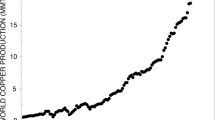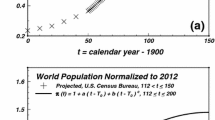Abstract
In recent years, the rate of consumption of minerals and energy has been increasing. Herein, a few fundamental components of mineral consumption including population growth, rising standard of living, advances in technology, and economic growth are analyzed. Copper is one of the best resources for illustrating the growth of metal consumption and components of that growth because statistical data for copper are quite comprehensive. Among the various factors examined, an index of rising standards of living is the most significant factors explaining growth of copper consumption.
Similar content being viewed by others
References
Al-Rawahi, K. and Rieber, M., 1990, Embodied net exports, the effects on intensity of use estimation and mineral demand forecasting: Resources Policy, v. 15, p. 200–209.
Chang, J. C., 1993, The role of major nonfuel minerals in the asian pacific rim economies: U.S. Bureau of Mines, Washington D.C., 51p.
Dobozi, I., 1990, The centrally planned economies; extravagant consumption,in Tilton, J. E., ed., World metal demand trends and prospects: Resources for the Future, Washington, D.C., p. 113–159.
Hutchison, R. S., and Tilton, J. E., 1987, Is the intensity of copper use still declining in the USA?: Natural Resources Forum, v. 11, p. 325–334.
Metallgesellschaft, A. G.: Metal Statistics.
Mining Journal: Mining Annual Review.
Nishiyama, T., and Adachi, T., 1995, Resource depletion calculated by the ratio of the reserve plus cumulative consumption to the crustal abundance for gold: Nonrenewable Resources, v. 4, p. 253–261.
Radetzki, M., and Tilton, J. E., 1990, Conceptual and methodological issues,in Tilton, J. E., ed., World metal demand trends and prospects: Resources for the Future, Washington, D.C., p. 27–28.
Skinner, B. J., 1976, Earth resources: Englewood Cliffs, NJ, Prentice-Hall, Inc., 151 p.
Tilton, J. E., ed., 1990, World metal demand trends and prospects: Resources for the Future, Washington, D.C., 341p.
United Nations: Statistical Yearbook.
U.S. Bureau of Mines: Minerals Yearbook, U.S. Department of the Interior.
U.S. Bureau of Mines: Mineral Commodity Summaries, U.S. Government Printing Office.
World Bureau of Metal Statistics: World Metal Statistics.
World Bank: World Tables.
Author information
Authors and Affiliations
Rights and permissions
About this article
Cite this article
Nishiyama, T. Trends and short-term prospects for copper demand. Nat Resour Res 5, 155–168 (1996). https://doi.org/10.1007/BF02257659
Received:
Accepted:
Issue Date:
DOI: https://doi.org/10.1007/BF02257659




